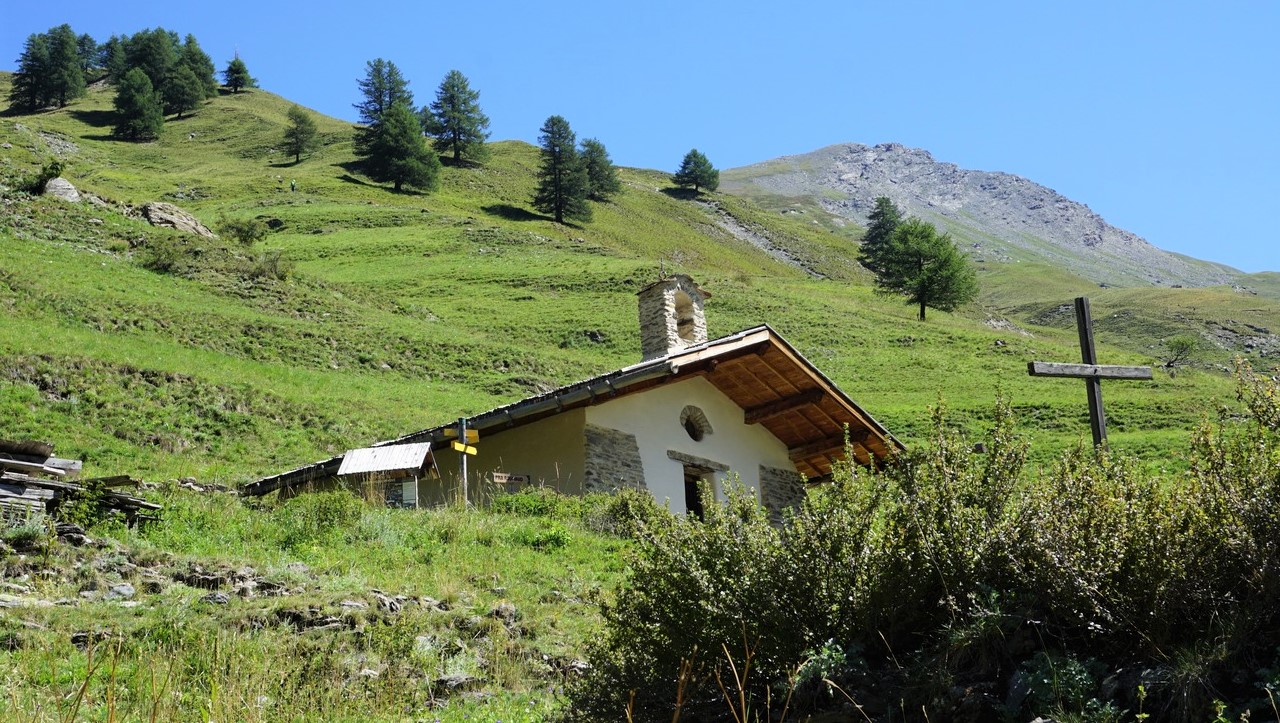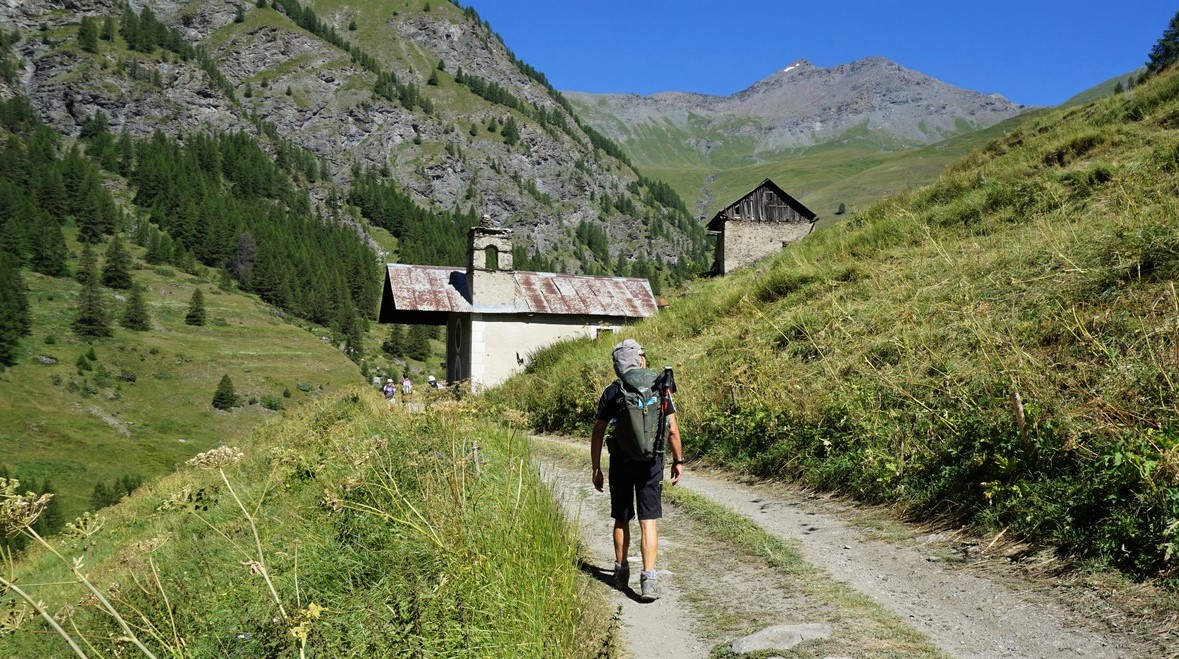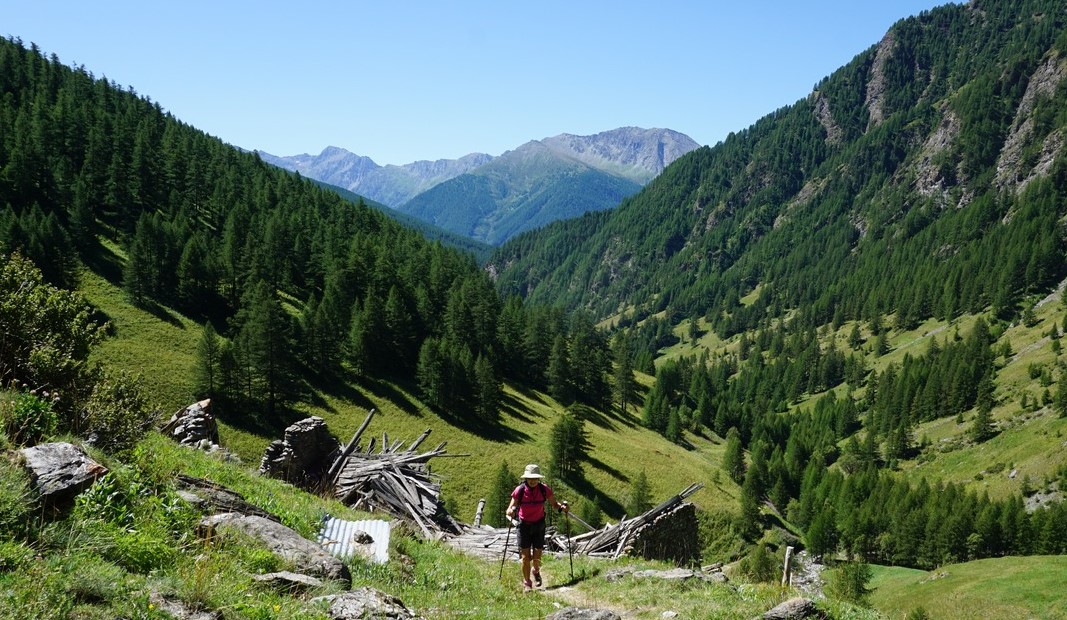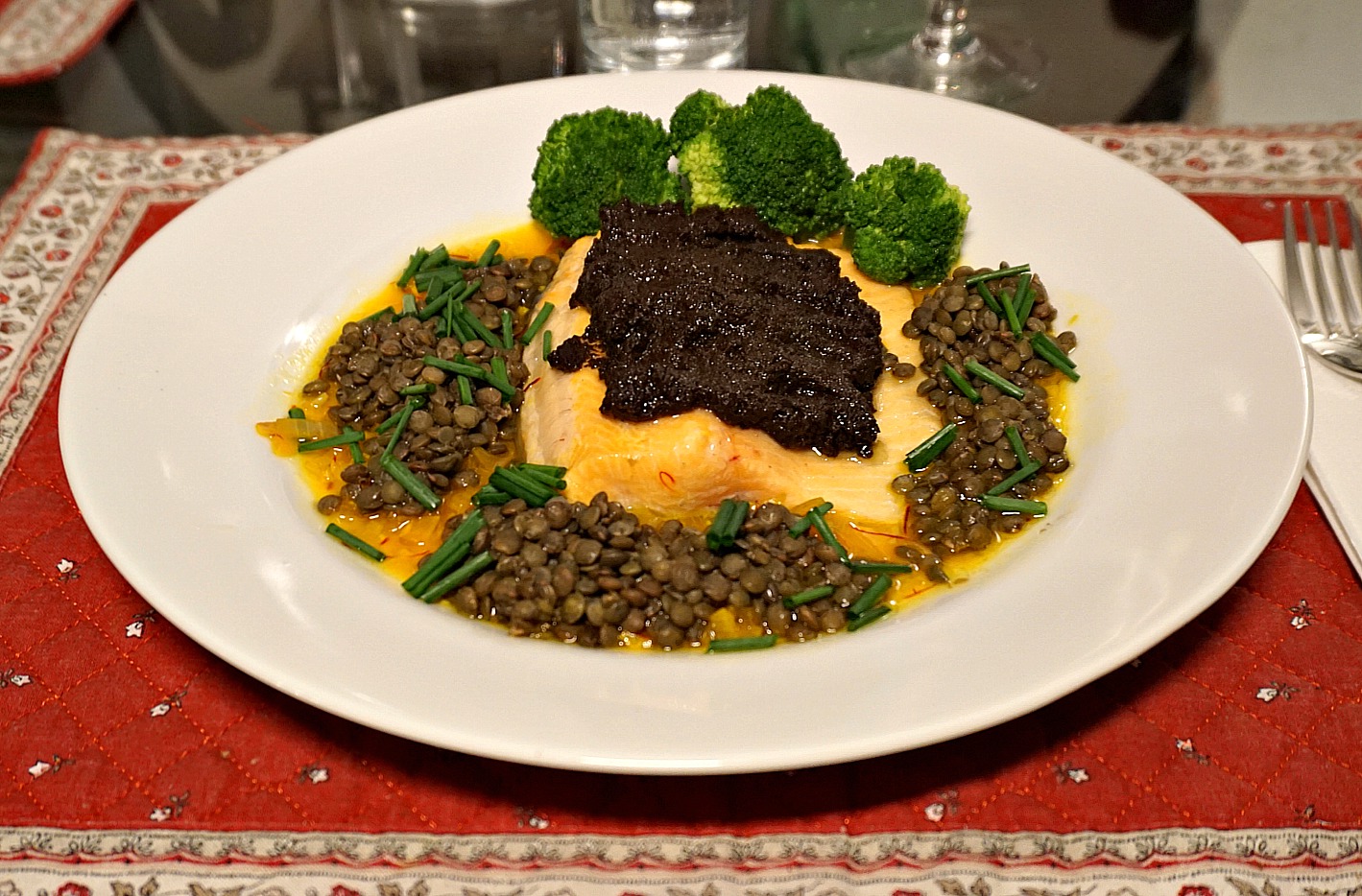Between longer and strenuous hikes, you might need a shorter leisurely walk to let your body recuperate.
If you are in Abriès (Queyras), the following walk serves this purpose perfectly.
We drove up to the village of Le Roux (1760 m) 4 km from Abriès. There are several parking possibilities at the village entrance.
We ascended through the village along a GR58 variant trail. There were a few buildings under reconstruction, whereas some were derelict.
We headed north towards the Montette Chapel. We walked along a dirt track which followed Torrent de la Montette. We reached a bend in the torrent, left the dirt road and crossed the stream along a bridge. Still on a GR58 trail, we now climbed steeply towards la Montette. The hamlet had been abandoned in the late 19th century, only ruins remained below the chapel which had been recently restored.
At the chapel, the GR58 trail forked left (northwest) to Col de Thures. We forked right and continued along a smaller PR path, heading east. Walking along alpine meadows, we passed a crossroads to Col de Mayt. Gradually, we descended towards Torrent du Col St-Martin which we crossed, then forked right (west), and followed a wide dirt track in the woods. The direction soon turned to the south, and we descended back to the same dirt road (GR58) used in the beginning of the walk from Le Roux.
Duration: 2h 20
Climb: 350 m
Distance: 6,6 km
Map: 3637 OT Mont Viso St-Véran Aguilles PNR du Queyras
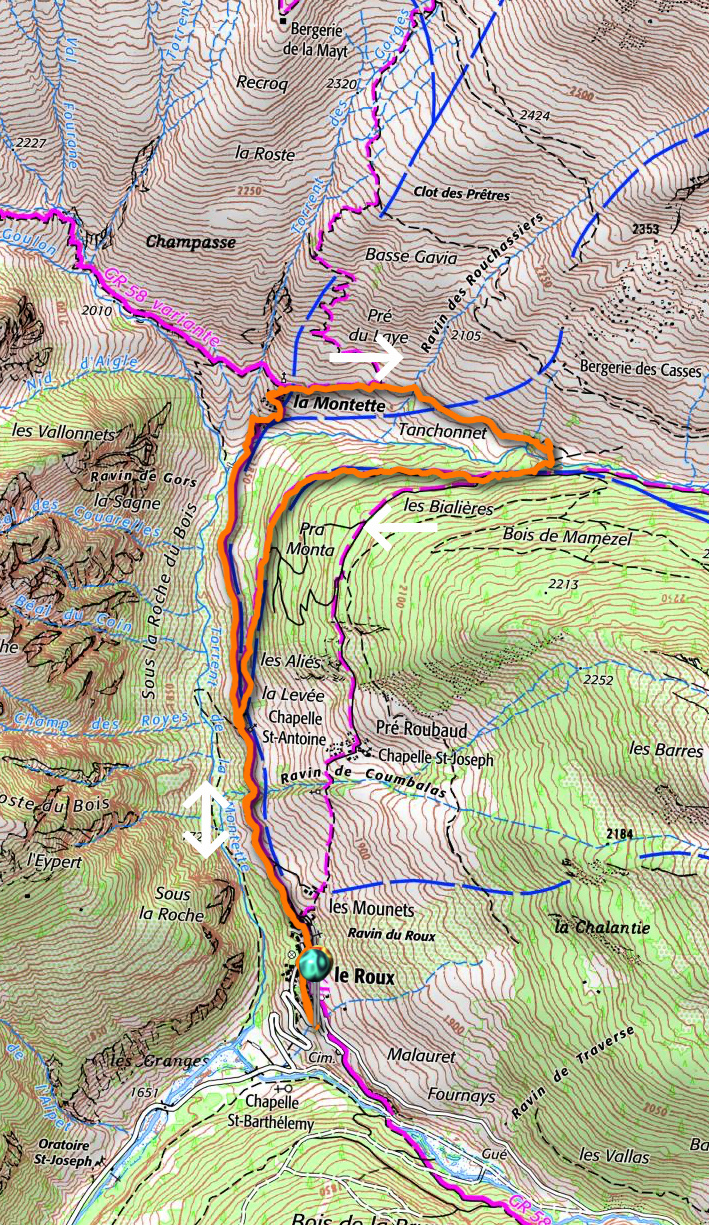 |
La Montette hike track
|
This recipe is a raw version of the classic spaghetti puttanesca. The secret of this simple pasta is in the very fresh and tasty ingredients; cherry tomatoes and basil at their best, freshly grated parmesan, organic whole wheat spaghetti, and the very best olive oil.
It is a great recipe to make during a heatwave as you only need to cook the spaghetti!
2 servings
A small tin of anchovy fillets in olive oil
A small shallot, minced
½ clove garlic, minced
2 tbsp. black olives, pitted and sliced
½ tsp. Piment d’Espelette or some other mild chilli
About 12 cherry tomatoes
About 3- 4 sprigs of basil
A handful of freshly grated parmesan
Olive oil
Organic whole wheat spaghetti for 2 servings
Soak the anchovies in water for 5- 10 minutes to remove some of the salt. Then dry with kitchen paper, place in a large bowl and chop.
Wash the cherry tomatoes, chop and place in a colander for 5- 10 minutes to get rid of the excess water.
Bring a casserole of water with a little olive oil to a boil for the spaghetti.
Slice the olives and add to the bowl with anchovies. Mince the shallot and garlic and add to the bowl. Add the Piment d’Espelette, cherry tomatoes, and 1 tbsp. olive oil and mix. Wash the basil leaves, chop and add to the bowl. Mix well.
Meanwhile cook the spaghetti and grate the parmesan.
When the spaghetti is cooked, drain it and divide into two bowls. Fold in the parmesan with a fork and divide the tomato sauce on top. Serve with a green side salad.
Gilly (2467 m) is a mid-altitude mountain above Abriès 1550 m). We are in Queyras Regional National Park, in the upper Guil River Valley.
The hiking trail around the mountain is included in some local guides and with a good reason: The trail offers a highly variable experience and great views. Moreover, the itinerary starts and ends in Abriès.
 |
Abriès centre
|
 |
Initial ascent from Abriès GR58
|
 |
Good signposts by the trail
|
 |
Bois de la Brune Abriès
|
 |
Le Roix and Bric Froid
|
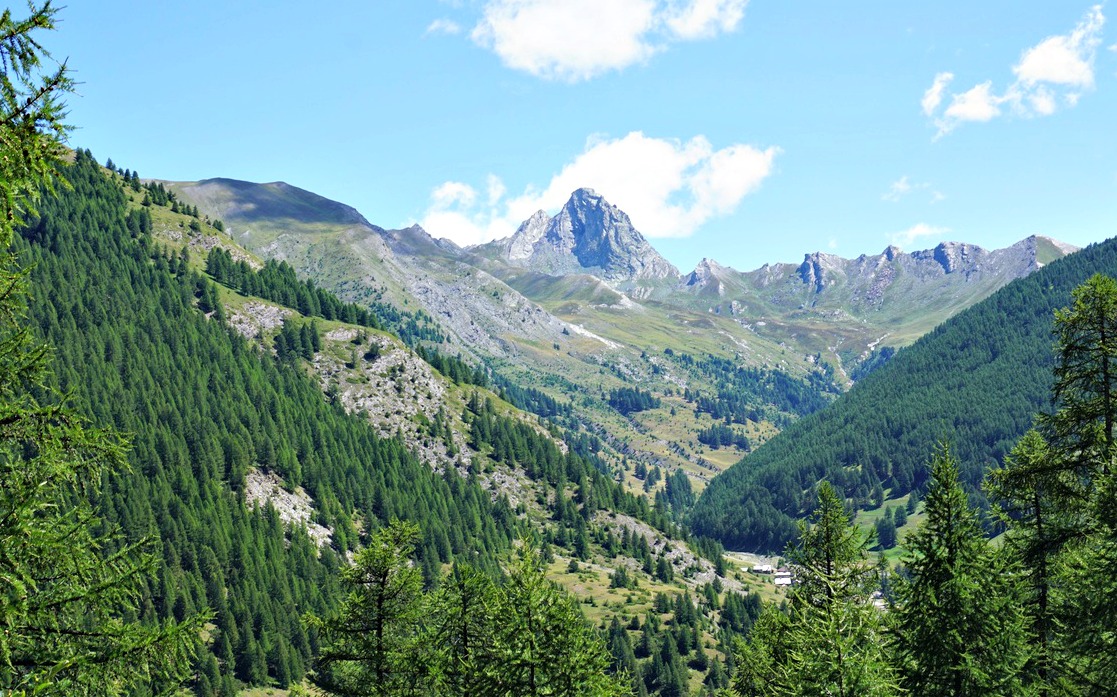 |
Bric Bouchet
|
From the village centre, we walked about 200 m along the D441 road, then forked right at the signpost indicating GR58, Collette de Gilly etc. We ascended past an oratory, heading northeast. We ignored several other trails which was easy as our trail was a GR itinerary, with the usual white/red markings. The direction turned to the east, and we came to Bois de la Brune, a beautiful larch forest on the northern flank of Gilly. We saw the hamlet of le Roux below us, and further away in the north, the summit of Bric Froid (3302 m). In front of us, we saw the hamlet of Valpréveyre and Bric Bouchet (2997 m).
 |
Bois Noir Abriès
|
 |
Collette de Gilly 2366 m
|
 |
View to west from Gilly summit
|
 |
Descending from Collette de Gilly
|
We continued quasi-horizontally, still heading east, and reached Bois Noir. We crossed Torrent des Estachons, and came to a crossroads where we forked right (south), and started to climb. The trail was very good all the way. We passed a signpost at Clot de Bessey, then continued mostly above the tree line to Collette de Gilly (2366 m). After a break and a detour to the summit of Gilly (100 m vertical climb; 20-25 minutes extra), we started the descent along the southwestern slope which comprised alpine meadows and some ski runs. Our trail zigzagged in the incline, then turned southeast under some ski lifts.
We came to a small pond named Etang du Moussou (1917 m). At this point, we left the GR trail which went down to Ristolas and took a PR (yellow) trail back to Abriès, passing some ruined buildings before reaching the D947 road. We crossed the Guil River along a bridge and took a footpath back to our starting point.
Distance: 14 km
Duration: 5 h
Climb: 920 m (including the summit)
Map: 3637 OT Mont Viso St-Véran Aguilles PNR du Queyras
 |
Gilly loop hike track
|
The upper Guil River Valley in the Queyras Regional National Park is a hiker’s paradise. Here, you’ll see trekkers doing a week-long Tour de Queyras as well as families using the same trail for shorter walks. The nature is spectacular and obviously Mont Viso (3841 m) on the Italian side gives the region a special appeal. The main villages here are Abriès, Aguilles and Ristolas.
 |
Signpost to Lac Egorgeou
|
Today’s hike goes from l’Echalp (7km from Abriès) to Lake Egorgéou (2394 m) along the Grand Randonnée 58 trail. In fact, GR 58 and its variants crisscross the mountains and valleys here. |
Leaving l'Echalp along GR58 south
|
 |
Bric Froid seen from trail to Lac Egorgeou
|
 |
Good GR58 trail to Lac Egorgeou
|
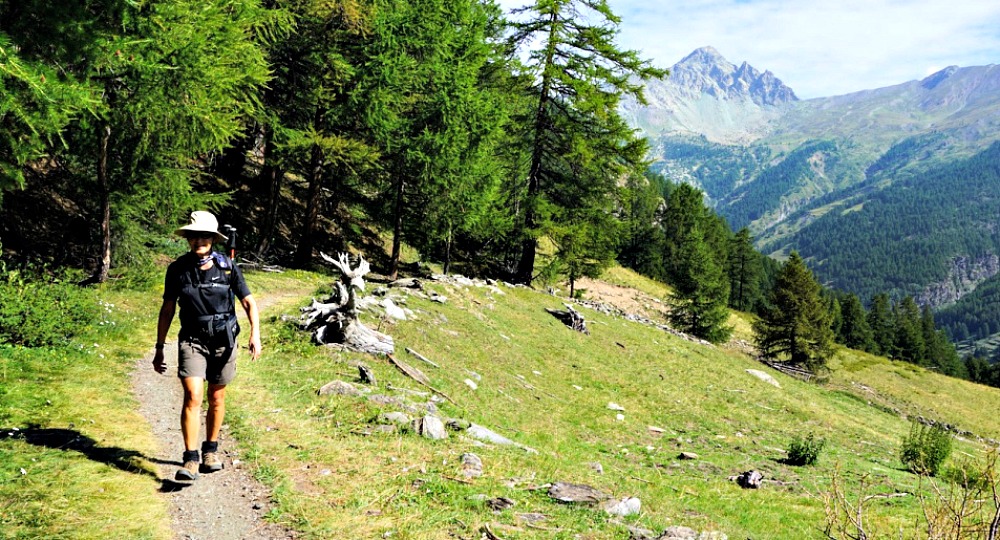 |
GR58 trail to Lac Egorgeou
|
 |
View to southeast from GR58 trail
|
 |
View over Guil River Valley from GR58
|
 |
Mont Viso seen from GR58 to Lac Egorgeou
|
We drove to l’Echalp (1700 m) from Abriès (1550 m) along a good paved road.
We crossed the Guil River along a wooden bridge, turned left and followed it a bit before starting to ascend along the GR58/ GRP Tour du Pain de Sucre. It was a straightforward itinerary, a well-marked (white-red) trail first through a mélèze, larch forest. The trail followed The Bouchouse Torrent. Mont Viso became visible in places. The imposing Crête de la Taillante in front of us was nearer, rising to 3197 m southeast of Lake Egorgéou.
 |
GR58 trail under Lac Egorgeou
|
 |
Approaching Lac Egorgeou from north
|
 |
Créte de la Taillante Queyras
|
 |
Lac Egorgeou view north
|
 |
Pain de Sucre summit seen from Lac Egorgeou
|
We climbed past some alpine meadows, meeting numerous hikers already on the way down to l’Echalp, and reached the beautiful mountain lake in 2h 20. From our picnic point above the lake, we saw a glimpse of Pan de Sucre (3208 m). The area is a protected habitat.
Having reached our planned goal today, we took the same trail back to our starting point.
Climb: 770 m
Distance: 11,4 km
Duration: 4h 20 active
Map: 3637 OT Mont Viso St-Véran Aguilles PNR du Queyras
 |
Lac Egorgeou trail track
|



